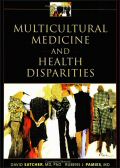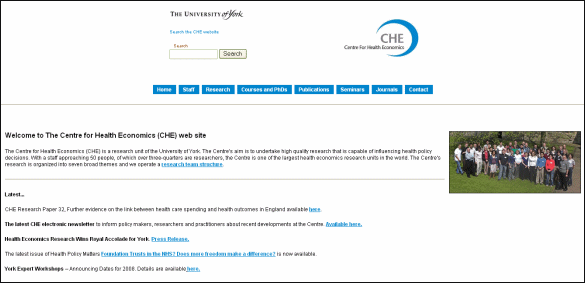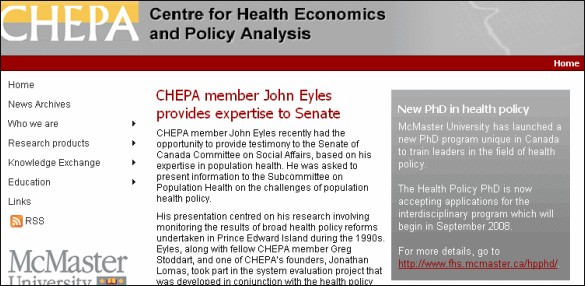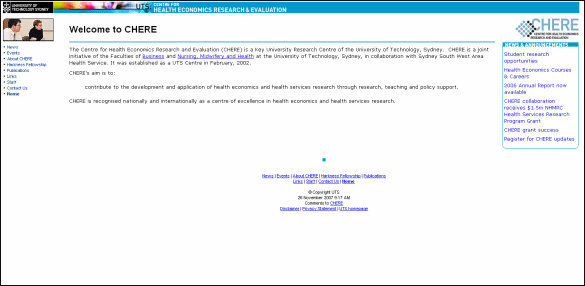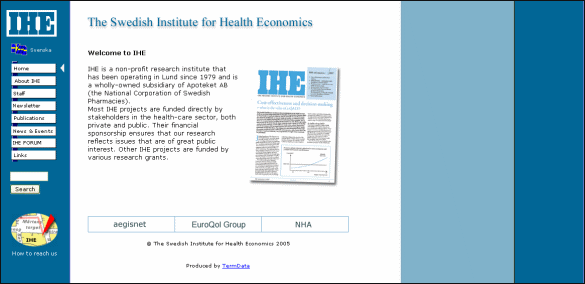LU POUR VOUS DE DECEMBRE 2007 : livres du mois - sites du mois - working papers
Tous les lu pour vous
LES LIVRES DU MOIS
La prise en charge de la santé mentale : recueil d'études statistiques.
Coldefy M. (coord.), Masse G. (préf.), Chaleix M. (introd.)
Paris : La documentation française : 2007 : 314 p.
Cet ouvrage collectif dresse un état des lieux de la prise en charge de la santé mentale en France, à partir des données statistiques disponibles. Ces dernières sont en effet nombreuses en France, mais elles sont dispersées et parfois difficilement accessibles. Pour la première fois, la Direction de la recherche, des études, de l'évaluation et des statistiques (Drees) rassemble et met à disposition des données issues de différentes sources, contribuant à améliorer la connaissance de f'offre de soins des professionnels, des patients pris en charge en psychiatrie (4e de couverture).
Critical perspectives in public health.
Perspectives critiques sur la santé publique.
Green J. (éd.), Labonte R. (éd.)
Abington : Routledge : 2007 : 248 p.
This book explores the concept of critical public health, at a point when many of its core concerns appear to have moved to the mainstream of health policy. Issues such as addressing health inequalities and their socioeconomic determinants, and the inclusion of public voices in policy-making, are now emerging as key policy aims for health systems across Europe and North America. Combining analytical introductory chapters, edited versions of influential articles from the journal Critical Public Health and specially commissioned review articles, this volume examines the contemporary roles of critical voices in public health research and practice from a range of disciplines and contexts. The book covers many of the pressing concerns for public health practitioners and researchers including : the implications of new genetic technologies for public health ; the impact of globalization on local practice : the politics of citizen participation in health programmes ; the impact of car-centred transport systems on health : the ethics of evaluation methods and the persistence of health inequalities. Critical Perspectives in Public Health is organized into sections covering four key themes in public health: social inequalities; evidence for practice; globalization; technologies and the environment. With contributions from a range of countries including the United States, Canada, the UK, Australia and South Africa, it provides an accessible overview for students, practitioners and researchers in public health, health promotion, health policy and related fields.
Multicultural medicine and health disparities.
Médecine multiculturelle et disparités de santé.
Satcher D., Pamies R.J.
New York : McGraw-Hill : 2006 : XIII-577 p.
The first comprehensive textbook on health disparities in the United States should hit the bookshelves in November, Dr. Rubens J. Pamies said at the annual meeting of the National Medical Association. Coedited by Dr. Pamies and Dr. David Satcher, former U.S. surgeon general and now director of Morehouse School of Medicine's National Center for Primary Care, Atlanta, the book compiles resources previously available only in journal articles. It should fill a number of needs, said Dr. Pamies, vice chancellor for academic affairs and professor of internal medicine at the University of Nebraska, Omaha. Fewer than half of U.S. medical schools offer a formal curriculum on health disparities, he noted. The book, with a working title of "Multicultural Medicine and Health Disparities," aims to provide a compendium of information not only for health care workers and administrators, but also for political scientists, sociologists, historians, and others. This could help broaden the national dialogue on health disparities and stimulate education of minority professionals, Dr. Pamies said. Chapters of the book by experts in different medical and health specialties will provide data on health problems facing racial and ethnic minorities and how these contribute to health disparities, compared with whites, as well as other disparities defined by geography, age, gender, disability status, or sexual orientation. The authors will forecast future problems expected if health disparities are not addressed and recommend steps that medical professionals can take to eliminate these disparities.
Governing home care : a cross-national comparison.
Comment gérer l'hospitalisation à domicile : une comparaison transnationale.
Burau V., Theobald H., Blank R.H.
Cheltenham : Edward Elgar Publishing Limited : 2007 : IX-224 p.
Care of the elderly in their own homes has increasingly come into the focus of contemporary welfare policies and raises important questions about the governance of welfare in general. By taking a comparative and thematic approach, this interesting and timely book offers a comprehensive analysis of the principal issues surrounding the governance of home care. The analysis presented systematically maps out governing arrangements in relation to formal and informal care services, informal care, care workers and users of care across nine countries. The authors explore the ways in which country specific contexts shape governing arrangements and bring together insights from social care and public policy literature, two different yet complementary theoretical perspectives. Combining social care and public policy, Governing Home Care will be of great interest to scholars and postgraduate students and researchers of comparative social and public policy, as well as gender studies with particular interest in health policy, welfare state policies, family studies, and the sociology of caring and ageing.
Social capital and health.
Capital social et santé.
Kawachi I. (éd.), Subramanian S.V. (éd.), Kim D.
New York : Springer : 2007 : 291 p.
As interest in social capital has grown over the past decade—particularly in public health —so has the lack of consensus on exactly what it is and what makes it worth studying. Social Capital and Health presents the state of the debate, from definition to conceptualization, from effective measurement to real-world applications. The 21 contributors discuss the potentials and pitfalls in current research, and salient examples of social capital concepts informing public health practice. The book's first section traces the theoretical origins of social capital, and the strengths and limitations of current methodologies of measuring it. The second half surveys the empirical data on social capital in key health areas. Among the highlights: Toward a definition: Individual or group entity? Negative as well as positive effects? ; Measurement methods: survey, sociometric, ethnographic, experimental; The relationship between social capital and physical health and health behaviors: smoking, substance abuse, physical activity, sexual activity; Social capital and mental health: early findings; Social capital and the aging community ; Applying social capital to health communications ; Social capital and disaster preparedness.
LES SITES DU MOIS DE DECEMBRE
Center for Health Economics (CHE)
http://www.york.ac.uk/inst/che/
Presentation
The Centre for Health Economics (CHE) est une unité de recherche affiliée à l'Université de York (Royaume- Uni) spécialisée en économie de la santé. Elle est organisée selon les sept grandes thématiques suivantes : politique de santé, évaluation économique des nouvelles technologies de santé, soins de santé primaires, addictions, allocation des ressources – déploiement et substitution, économétrie, mesures de santé.
Ce centre propose sur son site l'ensemble de ses documents de travail téléchargeables en ligne, une newsletter et le programme des différents séminaires qu'il organise. Il publie également deux revues de référence : Health Economics et le Journal of Health Economics.
Center for Health Economics and Policy Analysis (C.H.E.P.A.)
http://www.chepa.org/
Presentation
Le CHEPA est un institut de recherche de l'Université de McMaster (Canada). Ses domaines d'étude couvrent les champs de l'économie de la santé et l'analyse des politiques publiques. Une base de données interrogeable par auteur ou par mots-clés permet d'avoir accès aux références de ses publications.
Les documents de travail sont téléchargeables en ligne ainsi que leur lettre d'information et les rapports annuels d'activités.
Les activités du CHEPA sont présentées via le programme « Echanges de connaissances » (workshops, séminaires, newsletter électronique….).
Center for Health Economics Research Evaluation (C.H.E.R.E.)
http://www.chere.uts.edu.au/
Presentation
Centre de recherche de l'Université de Technologie de Sidney. Son but est de contribuer au développement et à l'application des recherches en économie de la santé et dans le domaine des services de santé.
Une base donnée permet une recherche de leurs publications par auteurs, par type de documents et résumé. Les documents de travail et de discussion ainsi que les comptes rendu de conférences sont accessibles gratuitement.
International Health Economics Association (I.H.E.A.)
http://www.healtheconomics.org/
Presentation
Basée au Canada, cette association a pour but d'améliorer la communication entre les économistes de la santé.
Elle donne des informations sur des congrès, publie une lettre d'information « Ihea week », présente une sélection d'ouvrages et de programmes de formation dans le domaine de l'économie de la santé
Office of Health Economics (OHE)
http://www.ohe.org/page/index.cfm
Presentation
L'objectif principal de cet organisme et de collecter et d'analyser des informations sur l'économie de la santé et les systèmes de soins pour le Royaume-Uni et les autres pays. Les axes de recherche sont les suivants : systèmes de santé, évaluation des technologies médicales, industrie pharmaceutique, épidémiologie et données statistiques sur la santé.
On retrouve sur ce site toutes les publications de l'OHE classées par thème et accompagnées d'un descriptif détaillé.
Un espace intitulé « Knowledge centre » permet d'avoir accès gratuitement mais sur inscription à des informations concernant l'économie de la santé et les politiques publiques y afférant. On peut trouver des articles de l ‘équipe de l'OHE, la totalité des publications de recherche depuis 40 ans, une newsletter, une sélection de liens utiles et des documents pédagogiques destinés aux étudiants. Un glossaire des principaux termes en économie de la santé complète utilement l'ensemble.
The Swedish Institute of Health Economics
http://www.ihe.se/english/index.htm
Presentation
Ses axes de recherche sont les suivants : évaluation des nouvelles technologies médicales et pharmaceutiques, organisation et financement du système de santé, le marché du médicament, soins de santé dans les pays développés, valeur et qualité de vie.
Il publie une lettre d'information trisannuelle « Ihe Informations » et des documents de travail disponibles en ligne (les plus récents ne sont pas disponibles en anglais).
VU DE L'ETRANGER : QUELQUES WORKING PAPERS ANALYSES
Inégalités de santé
Beyond the Health Concentration Index: An Atkinson Alternative for the Measurement of the Socioeconomic Inequality of Health. 
Au-delà de l'index de concentration santé : l'alternative d'Atkinson pour la mesure des inégalités de santé.
Erreigers G.
Antwerpen : University of Antwerp : 2006/10 : 27 p.
The Health Concentration Index is a frequently used indicator for the measurement of the socioeconomic inequality of health. This note starts from a discussion of some of the weaknesses of this index. It then presents two possible alternative measures. The .first is an adaptation of the Concentration Index. The second and more important of the two is constructed by following an Atkinson approach.
Inequalities in health in Scotland : what are they and what we can do about them. 
Les inégalités de santé en Ecosse : que sont-elles et que peut-on faire à ce sujet ?
Macintyre S.
Glasgow : MRC : 2007/10 : 19 p.
This paper outlines key facts about socio-economic inequalities in health in Scotland. It recommends key principles for effective policies to reduce inequalities in health. These include: Maintaining and extending equity in health and welfare systems ; Levelling up, not down ; Reducing inequalities in life circumstances, especially education, employment, and income ; Prioritising early years interventions, and families with children. Summarising lessons learnt from research on how best to reduce inequalities in health, the paper recommends putting a high priority on changes in the physical and social environment (for example, building and planning regulations, fiscal policies, and reducing price barriers to health-promoting goods and services), rather than information-based campaigns or interventions which require people to opt in.
Economic inequality and health: looking beyond aggregate indicators. 
Inégalité économique et santé : regarder au-delà des indicateurs agrégés.
Böckerman P., Johansson E., Helakorpi S., Uutela A.
Helsinki : the Research institute of the Finnish Economy : 2007 : 21 p.
This paper examines the relationship between relative income inequality and health in Finland, using individual microdata over the period 1993-2005. Our data allows us to analyse a large spectrum of health indicators. Overall, our results suggest that income inequality is not associated with increased morbidity in the population. The results for women differ to quite a large extent from those of men and the pooled sample. There is evidence that an increase in the Gini coefficient is negatively related to the probability of good physical health and no disability retirement. For men, relative income inequality is clearly not important for health.
Obésité
Overweight in adolescents : implications for health expenditures. 
Surpoids des adolescents : impact sur les dépenses de santé.
Monheit A.C., Vistines J.P., Rogowski J.A.
Cambridge : NBER : 2007/10 : 49 p.
We consider two compelling research questions raised by the increased prevalence of overweight among adolescents. First, what factors explain variation in adolescent bodyweight and the likelihood of being overweight? Next, do overweight adolescents incur greater health care expenditures compared to those of normal weight? We address the former question by examining the contribution of individual characteristics, economic factors, parental and family attributes, and neighborhood characteristics to variation in these bodyweight outcomes. For the second question, we estimate a two-part, generalized linear model of health spending. Using data from the Medical Expenditure Panel Survey, our econometric analyses indicate that adolescent bodyweight and the likelihood of being overweight are strongly associated with parental bodyweight, parental education, parental smoking behavior, and neighborhood attributes such as the availability of fresh food markets and convenience/snack food outlets, and neighborhood safety and material deprivation. Our expenditure model indicates that overweight females have annual expenditures that exceed those of normal weight by nearly $800 with part of the disparity explained by differences in mental health expenditures. We use both sets of empirical results to draw implications for policies to address adolescent overweight.
Professions de santé
Distribution and internal migration of Canada's Health Care workforce : summary report. 
Répartition et mobilité interne des professions de santé au Canada : résumé du rapport.
Brown J.R., Finkelstein A.
Ottawa : CIHI : 2007 : 45 p.
The distribution of health care providers is constantly changing. It is influenced by many factors such as both internal and external migration. Understanding and measuring where exactly these health professionals are located and how they move within the country is critical to the proper planning and management of the health care system. This series of reports uses a combination of Statistics Canada Census of Population and Scott's Medical Database data to examine internal migration - the movement of health care workers within provinces or territories or from one province or territory to another. Full reports were prepared for 15 health professional groups and data tables for an additional ten. In addition, the Summary Report: Distribution and Internal Migration of Canada's Health Care Workforce provides a consolidated overview of the internal migration patterns of Canada's health professionals.
The Future Direction of General Practice : A roadmap. 
La future direction de la médecine générale : une feuille de route.
Lakhani M., Baker M., Steve F.
Londres : Royal College of General Practitioners : 2007/09 : 84 p.
This sets out a vision for patient services in primary care in the 21st century. The roadmap provides a blue print for the delivery of services to patients and firmly establishes the discipline of family medicine. It shows how primary care can be scaled up by GPs to bring about major advances in clinical care using a new model of care and sets out a world-class vision for tackling crucial issues such as health inequalities and access. The status quo is not sustainable. Fragmentation of care, health inequalities and urgent care must be addressed. Furthermore, if we are to meet the health needs of patients over the coming years, we will need to bring about a radical change in the quality, organisation and delivery of services.
Santé et travail
Too old to work, too young to retire ? 
Trop vieux pour travailler, trop jeune pour partir à la retraite ?
Ichino A., Schwerdt G., Zweimuller J.
Bonn : IZA : 2007/10 : 35 p.
We use firm closure data from social security records for Austria 1978-1998 to investigate the effect of age on employment prospects. We rely on exact matching to compare workers displaced due to firm closure with similar non-displaced workers. We then use a difference in-difference strategy to analyze employment and earnings of older relative to prime-age workers in the displacement and on-displacement groups. Results suggest that immediately after plant closure the old have lower re-employment probabilities as compared to prime-age workers but later they catch up. While among the young the employment prospects of the displaced remain persistently different from those of the non-displaced, among the old the effect of displacement fades away, and actually disappears even immediately after plant closure when the effect of tenure based severance payment is controlled for. Our evidence suggests that increasing the retirement age does not necessarily produce individuals who are “too old to work but too young to retire”.
Optimal Retirement and Saving with Healthy Aging. 
Retraite optimale pour un vieillissement en bonne santé.
Bloom D.E., Canning D., Moore M.
Boston : Harvard Initiative for Global Health : 2007/09 : 40 p.
We construct a model in which retirement occurs at the end of life as a result of declining health. We show that improvements in life expectancy, coupled with a delay in the onset of disability, create a wealth effect that increases both the optimal consumption level and the proportion of life spent in leisure. For social security systems whose goal is to mimic optimal behavior, the appropriate response to longer, healthier lives is to reduce contribution rates and increase benefit rates, funded by an increase in the retirement age that is less than proportional to the increase in life expectancy.
Unemployment durability and disability : evidence from Portugal. 
Relation entre durée du chômage et handicap : le cas du Portugal.
Sciulli D., Gomes de Menezes A., Cabral Vieira J.
Bonn : IZA : 2007 : 20 p.
In this paper we use Portuguese data on individual (multiple) unemployment spells and apply semi-parametric duration models to investigate the effects of different types of disabilities on (re)employment probabilities. We find that disabled persons with muscular, skeletal, geriatric and sensorial problems experience the longest unemployment spells. Organic (blind, deaf or linguistic) disabilities also significantly reduce the probability of finding a job, while intellectual or psychological disabilities do not. We also find that having previous employment experience and vocational training raise the probability of leaving unemployment into employment. Negative duration dependence and unobserved heterogeneity are also found in the data. Policies that seek to promote job accessibility should take into account the heterogeneous nature of the effects of different disabilities on reemployment.
Systèmes de santé
Rationing the public provision of Healthcare in the presence of private supplements : the evidence of the italian NHS.

Rationner la production de soins publiques en présence d'une offre privée complémentaires : le cas du système de santé italien.
Fabri D., Monfardini C.
Turin : University of Torino, Department of Economics : 2006 : 31 p.
In this paper we assess the relative effectiveness of user charges and administrative waiting times as a tool for rationing public healthcare in Italy. We measure demand elasticities by estimating a simultaneous equation model of GP primary care visits, public specialist consultations and private specialist consultations, as if they were part of an incomplete system of demand. We find that own price elasticity of the demand for public specialist consultation is about -0.3, while administrative waiting time plays a less important role. No substitution exists between the demand for public and private specialists, so that user charges act as a net deterrent for ver-consumption. The public provision of healthcare does not induce the wealthy to opt out. Moreover our evidence suggests that user charges and waiting lists do not serve redistributive purposes.
Modelling the dynamics of a public health care system : evidence from time-series data. 
Modélisation de la dynamique du système de santé public : résultats issus de données de séries temporelles.
Iacone F., Martin S., Siciliani L., Smith P.C.
York : University of York : 2007/05 : 24 p.
The English National Health Service was established in 1948, and has therefore yielded some long time series data on health system performance. Waiting times for inpatient care have been a persistent cause of policy concern since the creation of the NHS. This paper develops a theoretical model of the dynamic interaction between key indicators of health system performance. It then investigates empirically the relationship between hospital activity, waiting times and population characteristics using aggregate time-series data for the NHS over the period 1952-2005. Structural Vector Auto-Regression suggests that in the long run: a) higher activity is associated with lower waiting times (elasticity = -0.9%); b) a higher proportion of old population is associated with higher waiting times (elasticity = 1.6%). In the short run, higher lagged waiting time leads to higher activity (elasticity = 0.2%). We also find that shocks in waiting times are countered by higher activity, so the effect is only temporary, while shocks in activity have a permanent effect. We conclude that policies to reduce waiting times should focus on initiatives that increase hospital activity.
Introducing activity-based financing : a review of experience in Australia, Denmark and Norway. 
Introduction du financement à l'activité : revue d'expériences menées en Australie au Danemark et en Norvège.
Street A., Vitikainen K., Bjorvatn A., Hvenegaard A.
York : University of York : 2007/11 : 14 p.
We review and evaluate the international literature on activity-based funding of health services, focussing especially on experience in Australia (Victoria), Denmark, Norway and Sweden. In evaluating this literature we summarise the differences and pros and cons of three different funding arrangements, namely cost-based reimbursement, global budgeting and activity-based financing. The institutional structures of the four jurisdictions that are the main focus of the review are described, and an outline is provided about how activity-based funding has been introduced in each. We then turn to the mechanics of activity-based funding and discuss in detail how patients are classified, how prices are set and how other services are funded. Although concentrating on the four jurisdictions, we draw on wider international experience to inform this discussion. We review evidence of the impact of activity-based funding in the four jurisdictions on efficiency, activity rates, waiting times, quality and overall expenditure. Finally we conclude with a brief commentary of some of the challenges that would have to be faced if implementing activity-based funding.
Mark versus Luke ? Appropriate methods for the evaluation of public health interventions. 
Mark contre Luke ? Méthodes appropriées pour l'évaluation des interventions en santé publique.
Claxton K., Sculpher M.J., Culyer A.J.
York : University of York : 2007/11 : 14 p.
The purpose of this paper is to demonstrate that a social decision making approach to evaluation can be generalised to interventions such as public health and national policies which have multiple objectives and impact on multiple constraints within and beyond the health sector. We demonstrate that a mathematical programming solution to this problem is possible, but the information requirements make it impractical. Instead we propose a simple compensation test for interventions with multiple and cross-sectoral effects. However, rather than compensation based on individual preferences, it can be based on the net benefits falling on different sectors. The valuation of outcomes is based on the shadow prices of the existing budget constraints, which are implicit in existing public expenditure and its allocation across different sectors. A ‘welfarist' societal perspective is not sufficient; rather, a multiple perspective evaluation which accounts for costs and effects falling on each sector is required.
Toxicomanie
Social interactions and smoking. 
Interactions sociales et tabagisme.
Cutler D.M., Glaeser E.L.
Cambridge : NBER : 2007/10 : 26p.
Are individuals more likely to smoke when they are surrounded by smokers? In this paper, we examine the evidence for peer effects in smoking. We address the endogeneity of peers by looking at the impact of workplace smoking bans on spousal and peer group smoking. Using these bans as an instrument, we find that individuals whose spouses smoke are 40 percent more likely to smoke themselves. We also find evidence for the existence of a social multiplier in that the impact of smoking bans and individual income becomes stronger at higher levels of aggregation. This social multiplier could explain the large time series drop in smoking among some demographic groups.


